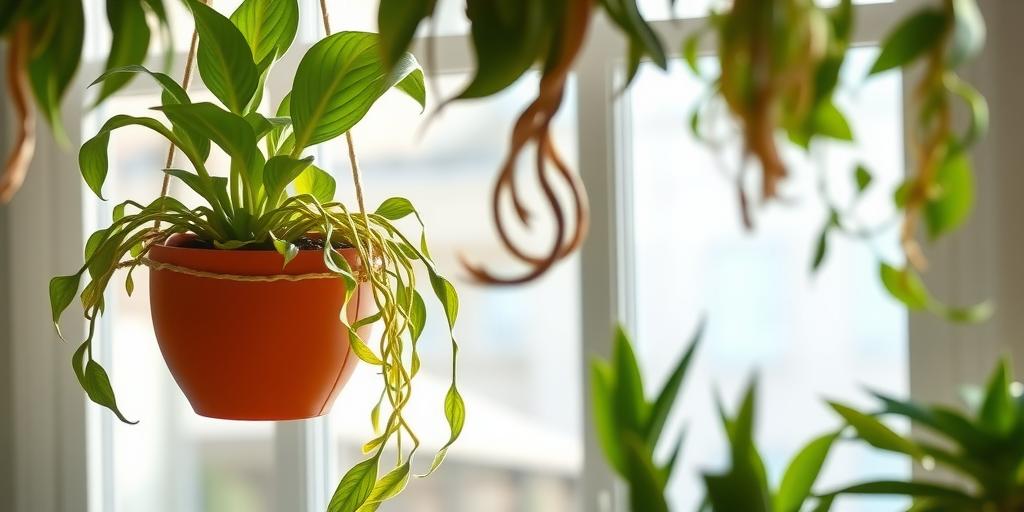
Low Light Hanging Plants for Beginners: A Complete Guide
Discover the best low light hanging plants for beginners! This guide covers easy-care options, placement tips, and expert advice to help you grow lush indoor greenery, even in dim spaces.
Introduction
Did you know that some of the most beautiful houseplants thrive in low light? If you’re a beginner looking to add greenery to your home but don’t have bright, sunny windows, don’t worry—there are plenty of stunning hanging plants that flourish in dim conditions! From the hardy Spider Plant to the elegant Pothos, this guide will walk you through the best low light hanging plants, care tips, and creative ways to display them. Let’s dive in and transform your space into a lush, green oasis—no sunlight required!
Best Low Light Hanging Plants for Beginners
Spider Plant – Hardy, Air-Purifying, and Easy to Propagate
Spider plants (Chlorophytum comosum) are one of the best choices for beginners because they thrive in low light and are incredibly forgiving. Their arching green and white striped leaves add a fresh, lively touch to any space. Plus, they’re excellent air purifiers, removing toxins like formaldehyde and xylene.
One of the coolest things about spider plants? They produce “pups”—tiny offshoots that dangle from the mother plant. You can snip these off and propagate them in water or soil, making it easy to expand your plant collection or share with friends.
Pothos (Devil’s Ivy) – Fast-Growing and Nearly Indestructible
If you’re looking for a plant that can handle neglect, pothos (Epipremnum aureum) is your best bet. Its heart-shaped leaves come in various shades, from deep green to variegated gold and white. Pothos grows quickly, even in low light, and can trail several feet if left untrimmed.
This plant is perfect for forgetful waterers because it tolerates occasional dry spells. Just be careful not to overwater—let the top inch of soil dry out before giving it a drink.
Philodendron Heartleaf – Adaptable and Great for Beginners
The heartleaf philodendron (Philodendron hederaceum) is another low-maintenance superstar. Its glossy, heart-shaped leaves cascade beautifully from hanging baskets, making it a favorite for indoor spaces. It adapts well to low light but will grow faster in brighter indirect light.
Like pothos, philodendrons are drought-tolerant and only need watering when the soil feels dry. They’re also easy to propagate—just snip a stem below a node and place it in water until roots develop.
String of Hearts – Delicate Trailing Beauty with Minimal Light Needs
For something a little more unique, try the string of hearts (Ceropegia woodii). This delicate trailing plant features small, heart-shaped leaves with silvery-green and purple hues. It thrives in low to moderate light and prefers to dry out between waterings.
Though it looks fragile, it’s surprisingly hardy. Just avoid overwatering, as its thin stems and leaves are prone to rot if kept too moist.
Peperomia – Compact, Low-Maintenance, and Perfect for Small Spaces
Peperomias come in many varieties, but most are compact and ideal for hanging planters. The watermelon peperomia (Peperomia argyreia) and trailing peperomia (Peperomia prostrata) are great choices for low light. Their thick leaves store water, making them drought-tolerant.
These plants stay small, so they’re perfect for apartments or rooms with limited space. They also rarely need repotting, which means less maintenance for you.
How to Care for Low Light Hanging Plants
Watering Tips – Avoid Overwatering; Let Soil Dry Slightly Between Waterings
Overwatering is the most common killer of houseplants, especially those in low light. Since these plants receive less sunlight, they don’t dry out as quickly. Always check the soil before watering—stick your finger an inch deep. If it feels dry, it’s time to water. If it’s still damp, wait a few more days.
Plants like pothos and philodendrons prefer to dry out a bit between waterings, while peperomias and string of hearts need even less frequent watering.
Soil Requirements – Well-Draining Mix to Prevent Root Rot
A well-draining potting mix is essential for preventing root rot. Look for a blend that includes perlite, orchid bark, or coco coir to improve aeration. Avoid heavy garden soil, which retains too much moisture.
For extra drainage, consider adding a layer of pebbles at the bottom of the pot or using a hanging planter with drainage holes.
Fertilizing – Use Diluted Liquid Fertilizer Every 4-6 Weeks
Low light plants grow slower, so they don’t need frequent feeding. A balanced, water-soluble fertilizer diluted to half strength every 4-6 weeks during the growing season (spring and summer) is enough. Skip fertilizing in fall and winter when growth slows.
Pruning & Maintenance – Trim Leggy Growth to Encourage Bushiness
If your plant starts looking sparse or leggy, don’t hesitate to give it a trim. Cutting back long vines encourages fuller growth. You can propagate the cuttings in water or soil to grow new plants.
Regularly remove yellow or dead leaves to keep your plant healthy and prevent pests.
Ideal Placement for Low Light Hanging Plants
North-Facing Windows – Soft, Indirect Light Works Best
North-facing windows provide gentle, indirect light—perfect for low light plants. These spots won’t get harsh sun, reducing the risk of leaf burn. Spider plants, pothos, and philodendrons thrive here.
Bathrooms & Hallways – Great for Humidity-Loving Plants
Bathrooms with small windows or hallways with minimal light can be great spots for humidity-loving plants like pothos and philodendrons. The extra moisture in the air helps keep their leaves lush.
Avoid Direct Sunlight – Can Scorch Leaves in Low-Light Varieties
While some plants tolerate low light, they’re not built for direct sun. Harsh sunlight can scorch their leaves, causing brown, crispy patches. If your only option is a bright window, hang your plant a few feet away or use a sheer curtain to filter the light.
Common Problems & Solutions
Yellow Leaves – Often a Sign of Overwatering
Yellowing leaves usually mean too much water. Check the soil—if it’s soggy, let it dry out completely before watering again. If the problem persists, consider repotting in fresh, well-draining soil.
Leggy Growth – Move to a Slightly Brighter Spot or Prune
If your plant is stretching out with long gaps between leaves, it might need more light. Move it closer to a window (but avoid direct sun). Alternatively, prune the leggy stems to encourage bushier growth.
Pests – Treat with Neem Oil or Insecticidal Soap
Spider mites, mealybugs, and aphids can sometimes attack indoor plants. If you spot tiny bugs or webbing, wipe the leaves with a damp cloth and treat with neem oil or insecticidal soap.
Creative Ways to Display Hanging Plants
Macramé Hangers – Stylish and Space-Saving
Macramé hangers add a boho-chic vibe to any room while keeping plants off tables and shelves. They’re perfect for trailing plants like string of hearts or pothos.
Wall-Mounted Shelves – Perfect for Trailing Plants
Floating shelves allow you to display multiple plants at different heights, creating a lush, cascading effect. Mix small peperomias with longer philodendrons for visual interest.
Tiered Planters – Adds Depth to Small Spaces
Tiered planters or hanging baskets with multiple levels maximize vertical space. They’re ideal for grouping small plants like spider plants and peperomias together.
Conclusion
Low light doesn’t mean no plants! With the right choices and care, you can enjoy lush, trailing greenery in even the dimmest corners of your home. Start with easy-care options like Pothos or Spider Plants, follow our care tips, and experiment with creative displays. Ready to bring life to your space? Pick your favorite low light hanging plant and get growing today!
